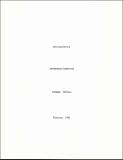Reversible Computing
Author(s)
Toffoli, Tommaso
DownloadMIT-LCS-TM-151.pdf (16.21Mb)
Metadata
Show full item recordAbstract
The theory of reversible computing is based on invertible primitives and composition rules that preserve invertibility. With these constraints, one can still satisfactorily deal with both functional and structural aspects of computing processes; at the same time, one attains a closer correspondence between the behavior of abstract computing systems and the microscopic physical laws (which are presumed to be strictly reversible) that underly any concrete implementation of such systems. Here, we integrate into a comprehensive picture a variety of concepts and results. According to a physical interpretation, the central result of this paper is that it is ideally possible to build sequential circuits with zero internal power dissipation. Even when these circuits are interfaced with conventional ones, power dissipation at the interface would be at most proportional to the number of input/output lines, rather than to the number of logic gates as in conventional computers.
Date issued
1980-02Series/Report no.
MIT-LCS-TM-151